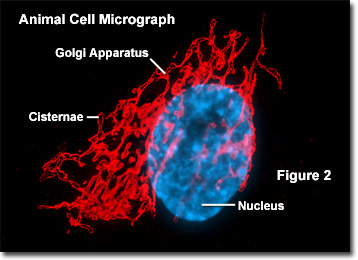What Does The Golgi Apparatus Do In A Animal Cell
The Golgi Apparatus
The Golgi appliance (GA), too called Golgi body or Golgi circuitous and found universally in both plant and creature cells, is typically comprised of a series of v to eight loving cup-shaped, membrane-covered sacs called cisternae that look something like a stack of deflated balloons. In some unicellular flagellates, even so, every bit many as 60 cisternae may combine to brand up the Golgi apparatus. Similarly, the number of Golgi bodies in a cell varies according to its function. Animate being cells generally contain between ten and twenty Golgi stacks per jail cell, which are linked into a single complex by tubular connections between cisternae. This complex is usually located close to the cell nucleus.

Due to its relatively large size, the Golgi apparatus was one of the start organelles ever observed. In 1897, an Italian physician named Camillo Golgi, who was investigating the nervous system by using a new staining technique he developed (and which is still sometimes used today; known as Golgi staining or Golgi impregnation), observed in a sample under his low-cal microscope a cellular structure that he termed the internal reticular apparatus. Before long later he publicly announced his discovery in 1898, the structure was named after him, becoming universally known as the Golgi apparatus. Yet, many scientists did not believe that what Golgi observed was a real organelle present in the cell and instead argued that the apparent body was a visual distortion caused by staining. The invention of the electron microscope in the twentieth century finally confirmed that the Golgi appliance is a cellular organelle.
The Golgi apparatus is often considered the distribution and shipping department for the cell's chemical products. It modifies proteins and lipids (fats) that have been built in the endoplasmic reticulum and prepares them for export outside of the cell or for send to other locations in the cell. Proteins and lipids built in the smooth and rough endoplasmic reticulum bud off in tiny bubble-like vesicles that move through the cytoplasm until they reach the Golgi complex. The vesicles fuse with the Golgi membranes and release their internally stored molecules into the organelle. One time within, the compounds are further processed by the Golgi apparatus, which adds molecules or chops tiny pieces off the ends. When completed, the production is extruded from the GA in a vesicle and directed to its final destination within or exterior the cell. The exported products are secretions of proteins or glycoproteins that are part of the jail cell'south part in the organism. Other products are returned to the endoplasmic reticulum or may undergo maturation to become lysosomes.

The modifications to molecules that take place in the Golgi apparatus occur in an orderly fashion. Each Golgi stack has two distinct ends, or faces. The cis confront of a Golgi stack is the end of the organelle where substances enter from the endoplasmic reticulum for processing, while the trans confront is where they exit in the form of smaller detached vesicles. Consequently, the cis confront is found near the endoplasmic reticulum, from whence near of the material it receives comes, and the trans face up is positioned near the plasma membrane of the jail cell, to where many of the substances it modifies are shipped. The chemical brand-upwards of each face is dissimilar and the enzymes contained in the lumens (inner open spaces) of the cisternae betwixt the faces are distinctive. Illustrated in Effigy 2 is a fluorescence digital image taken through a microscope of the Golgi apparatus (pseudocolored ruby-red) in a typical creature prison cell. Note the close proximity of the Golgi membranes to the cell nucleus.
Proteins, carbohydrates, phospholipids, and other molecules formed in the endoplasmic reticulum are transported to the Golgi apparatus to be biochemically modified during their transition from the cis to the trans poles of the circuitous. Enzymes present in the Golgi lumen change the carbohydrate (or saccharide) portion of glycoproteins by calculation or subtracting individual carbohydrate monomers. In addition, the Golgi apparatus manufactures a variety of macromolecules on its own, including a variety of polysaccharides. The Golgi circuitous in establish cells produces pectins and other polysaccharides specifically needed by for plant structure and metabolism. The products exported by the Golgi appliance through the trans face somewhen fuse with the plasma membrane of the cell. Among the nigh important duties of the Golgi apparatus is to sort the broad variety of macromolecules produced by the cell and target them for distribution to their proper location. Specialized molecular identification labels or tags, such as phosphate groups, are added by the Golgi enzymes to assistance in this sorting effort.
Back TO ANIMAL CELL Structure
Back TO Found Prison cell STRUCTURE
Questions or comments? Send us an e-mail.
© 1995-2022 by Michael Westward. Davidson and The Florida Country University. All Rights Reserved. No images, graphics, software, scripts, or applets may be reproduced or used in whatsoever manner without permission from the copyright holders. Use of this website ways you hold to all of the Legal Terms and Atmospheric condition ready forth by the owners.
This website is maintained by our
Graphics & Web Programming Squad
in collaboration with Optical Microscopy at the
National High Magnetic Field Laboratory.
Final modification: Fri, Nov 13, 2015 at 02:xviii PM
Access Count Since October ane, 2000: 1450684
Microscopes provided by:
Source: https://micro.magnet.fsu.edu/cells/golgi/golgiapparatus.html
Posted by: rodgerspromptiff.blogspot.com

0 Response to "What Does The Golgi Apparatus Do In A Animal Cell"
Post a Comment